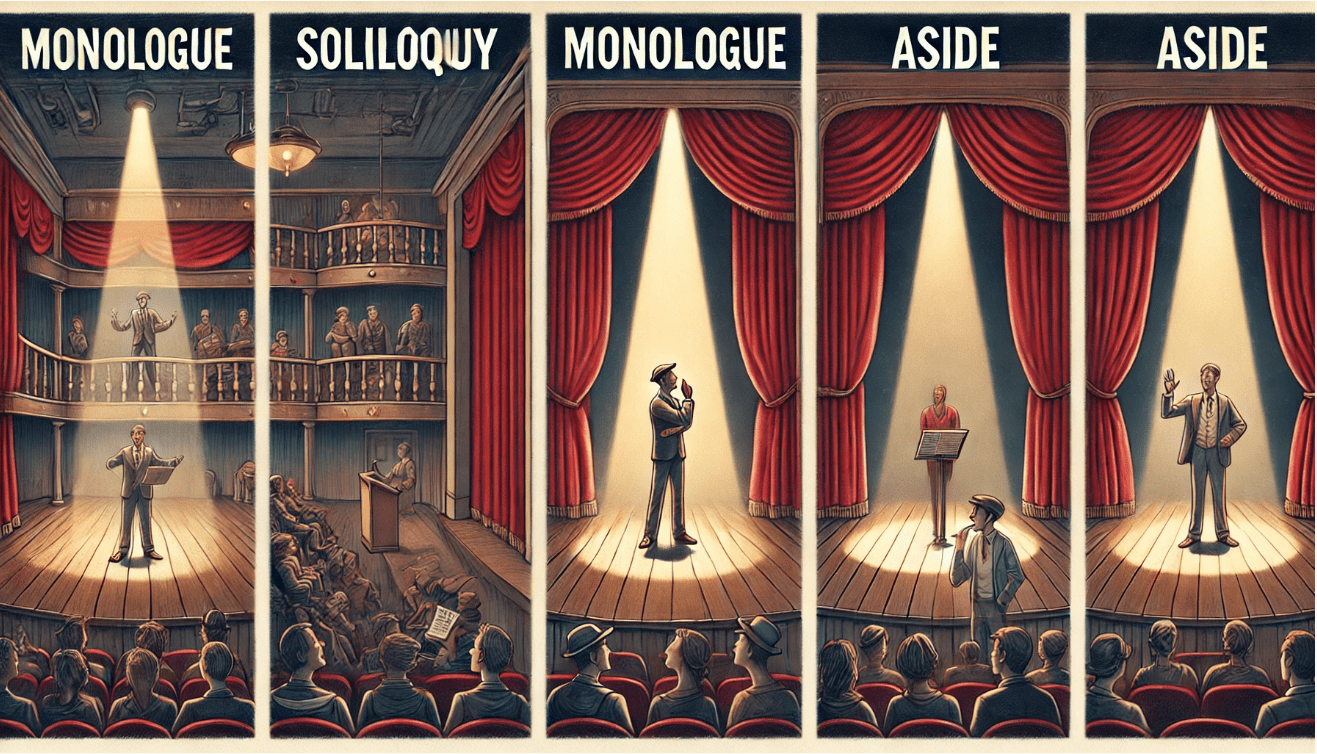
How to Understand Shakespeare’s Approach to Soliloquy Writing: A Practical Guide for Students and Enthusiasts
Ever wondered what goes on inside Hamlet’s mind as he questions life itself? 🎭 Shakespeare’s soliloquies, like the iconic “To be or not to be,” are the heartbeat of his plays, revealing raw emotions and hidden motives. Yet, for students and enthusiasts, Shakespeare’s approach to soliloquy writing can feel daunting—complex language and deep themes often leave readers lost. 😕 This practical guide demystifies soliloquies, offering clear, beginner-friendly steps to unlock their meaning. Whether you’re studying for class or savoring Shakespeare’s genius, you’ll gain tools to confidently analyze and enjoy these powerful moments. Keep reading to discover how! 🚀
Table of Contents
Toggle1: What Is a Soliloquy and Why Does It Matter?
A soliloquy is a moment in a play where a character speaks their thoughts aloud, alone on stage. It’s like a window into their soul, showing what they’re feeling and thinking without anyone else around. In Shakespeare’s plays, soliloquies are a key part of his storytelling magic. They let us dive deep into a character’s mind, revealing secrets, struggles, and dreams. 😊

Take Hamlet’s famous “To be or not to be” speech. He’s wrestling with life-and-death questions, and we’re right there with him. Or think of Macbeth’s “Is this a dagger which I see before me?”—it shows his guilt and fear taking over. These moments make Shakespeare’s characters feel real and relatable.
So, how is a soliloquy different from other speeches? Unlike a monologue, which might be spoken to others, or an aside, which is a quick thought shared with the audience, a soliloquy is private and personal. It’s just the character and their raw emotions.
Why does this matter? Soliloquies help you:
- Connect with characters: You see their true selves, like Hamlet’s doubts or Lady Macbeth’s ambition.
- Understand the story: They reveal plot points and motivations.
- Explore big ideas: Themes like love, power, or fate shine through.
For students and fans, soliloquies are your key to unlocking Shakespeare’s genius. They make his plays more than just words—they bring the human experience to life. 🌟
2: Key Elements of Shakespeare’s Soliloquy Writing
Shakespeare’s soliloquies are like a masterclass in storytelling. They’re packed with techniques that make characters unforgettable and stories gripping. Let’s break down the key elements of Shakespeare’s approach to soliloquy writing to help you understand and appreciate them. Ready to dive in? 😊
- Poetic Language and Imagery
Shakespeare uses rich, vivid language to paint pictures in your mind. His soliloquies often feature metaphors, similes, and iambic pentameter—a rhythmic pattern that feels like a heartbeat. For example, in Macbeth, the line “Life’s but a walking shadow” compares life to something fleeting and empty, sticking with you long after you read it. - Emotional Depth
Soliloquies dig into raw emotions—think Hamlet’s despair or Lady Macbeth’s ruthless ambition. These speeches let characters spill their hearts, showing complex feelings like guilt, love, or fear. This emotional honesty makes you feel connected to the character, even 400 years later. ❤️

- Thematic Connection
Every soliloquy ties to the play’s big ideas. In Romeo and Juliet, Juliet’s “O Romeo, Romeo” speech explores love and conflict. In Othello, Iago’s soliloquies reveal jealousy and betrayal. Spotting these themes helps you see the bigger picture of the story. - Audience Engagement
Shakespeare often has characters “talk” to the audience through rhetorical questions or direct address. In Hamlet, when Hamlet asks, “To be or not to be,” it feels like he’s inviting you to ponder life’s mysteries with him. This pulls you into the play’s world. 🎭
3: How to Analyze a Shakespearean Soliloquy
Analyzing a Shakespearean soliloquy can feel like cracking a code, but it’s easier than it seems! With a clear, step-by-step approach, you can unlock the meaning behind these powerful speeches. Whether you’re a student prepping for an exam or an enthusiast eager to dive deeper, this guide will make soliloquies approachable and fun. Let’s get started! 😊

1: Read the Soliloquy in Context
Before diving into the words, understand where the soliloquy fits in the play. What’s happening to the character? For example, in Hamlet (Act 3, Scene 1), Hamlet’s “To be or not to be” soliloquy comes when he’s torn about seeking revenge. Knowing the context helps you see why the character feels the way they do.
2: Break Down the Language
Shakespeare’s words can seem tricky, but don’t worry! Look for key phrases, metaphors, or repeated words. For instance, in Macbeth, “Tomorrow, and tomorrow, and tomorrow” uses repetition to show despair. Use a modern translation (like No Fear Shakespeare) or a glossary to clarify unfamiliar terms. Reading aloud helps you feel the rhythm too! 📖
3: Trace the Emotional Journey
Notice how the character’s emotions shift. Does their tone change from angry to sad? In Hamlet’s soliloquy, he starts questioning life’s worth and ends in quiet resignation. Jot down these shifts to follow the character’s inner struggle—it’s like mapping their heart.
4: Connect to Themes
Soliloquies often tie to the play’s big ideas. In Othello, Iago’s soliloquies reveal jealousy and deception, key themes of the play. Ask: How does this speech reflect the story’s deeper messages? This step makes your analysis richer and more meaningful.
5: Consider Performance
Imagine how an actor might deliver the soliloquy. Would they pause, shout, or whisper? Watch clips of performances (like the RSC’s Hamlet) to see how tone and pacing bring the words to life. This helps you feel the soliloquy’s impact. 🎭
Practical Tip: Grab a notebook and annotate the soliloquy. Highlight key words, note emotions, and jot down themes. Try summarizing the speech in one sentence to test your understanding. For example, Hamlet’s soliloquy might be: “Hamlet debates whether life is worth living.”
4: Common Challenges and How to Overcome Them
Diving into Shakespeare’s soliloquies can feel like a hurdle, especially for beginners. The language, emotions, and context might seem overwhelming, but don’t worry! 😊 Below, we tackle the most common challenges and share practical solutions to make soliloquies approachable and enjoyable. Let’s conquer those barriers together!
Challenge 1: Archaic Language
Shakespeare’s words, like “thee” or “wherefore,” can feel like a foreign language. This makes soliloquies hard to grasp at first.
 Solution: Use tools like No Fear Shakespeare or the Folger Shakespeare Library’s glossaries to translate tricky terms. Try reading the soliloquy aloud to catch the rhythm of iambic pentameter—it’s like a song! For example, in Hamlet’s “To be or not to be,” a modern translation can clarify phrases like “slings and arrows.” 📚
Solution: Use tools like No Fear Shakespeare or the Folger Shakespeare Library’s glossaries to translate tricky terms. Try reading the soliloquy aloud to catch the rhythm of iambic pentameter—it’s like a song! For example, in Hamlet’s “To be or not to be,” a modern translation can clarify phrases like “slings and arrows.” 📚
Challenge 2: Complex Emotions
Soliloquies often dive into intense feelings, like Hamlet’s despair or Lady Macbeth’s guilt, which can be tough to follow.
Solution: Summarize the character’s emotions in your own words. For instance, rewrite Macbeth’s “Tomorrow, and tomorrow, and tomorrow” as “feeling hopeless about life’s meaning.” This makes the emotions relatable. Discussing with a friend or study group can also spark new insights. 🗣️
Challenge 3: Lack of Context
Without knowing the play’s story, a soliloquy might feel like a puzzle with missing pieces.
Solution: Read a quick plot summary or watch a short performance clip before tackling the soliloquy. For example, understanding that Hamlet is debating revenge helps his soliloquy make sense. Websites like SparkNotes or YouTube clips from the Globe Theatre are great starting points. 🎥
Practical Exercise: Pick a soliloquy, like Juliet’s “O Romeo, Romeo,” and try this: Write one sentence summarizing its main idea, then share it with a friend or online forum for feedback. This builds confidence and deepens understanding.
5: Applying Soliloquy Analysis to Your Studies or Enjoyment
Now that you understand Shakespeare’s soliloquies, how can you use this knowledge? Whether you’re a student acing an exam or an enthusiast savoring a play, analyzing soliloquies can boost your confidence and deepen your love for Shakespeare. Here’s how to apply these skills in practical, fun ways. Let’s make Shakespeare yours! 😊
For Students: Shine in Your Studies
Soliloquies are gold for schoolwork! Use your analysis skills to stand out.
- Write Strong Essays: Compare soliloquies, like Hamlet’s “To be or not to be” and Macbeth’s “Tomorrow, and tomorrow, and tomorrow,” to explore themes like despair.
- Ace Discussions: Share insights about a soliloquy’s emotions or themes in class. For example, explain how Lady Macbeth’s “Unsex me here” reveals her ambition.
- Practical Tip: Create a chart listing a soliloquy’s key lines, emotions, and themes to organize your thoughts for papers or tests. 📝
For Enthusiasts: Deepen Your Enjoyment
Love Shakespeare? Soliloquies can make your experience richer!
- Watch Performances: Check out soliloquies in action, like Kenneth Branagh’s Hamlet (1996) or the RSC’s Macbeth (2018). Notice how actors bring emotions to life.
- Join the Conversation: Share your thoughts in a book club or online forum, like Reddit’s r/shakespeare. Discuss why Iago’s soliloquies in Othello are so chilling.
- Practical Tip: Watch different versions of the same soliloquy on YouTube to see how actors’ choices change its impact. 🎭
Creative Application: Try Writing Your Own
Want to get hands-on? Write a soliloquy inspired by Shakespeare!

- Prompt: Create a soliloquy for a modern character facing a tough choice, like a student debating a career path. Use vivid imagery and emotional shifts, just like Shakespeare.
- Example: “Shall I chase dreams or cling to safety’s shore?”
- Practical Tip: Share your soliloquy with a friend or post it online for feedback—it’s a fun way to connect with Shakespeare’s style. ✍️
Resource List
- Free Tools: Folger Shakespeare Library (folger.edu) for texts and glossaries; Shakespeare’s Words (shakespeareswords.com) for definitions.
- Performances: Stream Globe Theatre productions or check out BBC’s Shakespeare adaptations.
- Communities: Join the Shakespeare subreddit or local theater groups to swap ideas.
By applying these tips, you’ll turn soliloquy analysis into a tool for success and enjoyment. Whether it’s scoring an A or feeling closer to Shakespeare’s world, you’re ready to shine! 🌟
6: Case Study — Analyzing Hamlet’s “To Be or Not to Be” 🎭
When it comes to Shakespearean soliloquies, Hamlet’s “To be or not to be” is arguably the most famous—and for good reason. This short but powerful speech is a masterclass in how Shakespeare uses soliloquy to reveal inner conflict, deepen character, and explore big questions. Let’s break it down in a way that’s practical, beginner-friendly, and immediately useful for your own analysis or performance. 💡
🔍 What’s the Purpose of the Soliloquy?
Hamlet isn’t just talking for the sake of drama. He’s wrestling with existence itself. The famous opening line—“To be, or not to be: that is the question”—sets the tone. He’s asking whether it’s better to live and suffer or to end it all and face the unknown after death.
🧠 Key Emotions: Fear, Doubt, and Philosophical Reflection
Throughout the speech, Hamlet moves through a range of emotions:

- Fear of suffering: He lists “the slings and arrows of outrageous fortune.”
- Resentment: He mentions “the oppressor’s wrong,” “the law’s delay,” and “the insolence of office.”
- Doubt and paralysis: He’s not sure if death is a release or something worse.
🧩 Language Techniques in Action
Shakespeare uses specific tools to make this soliloquy resonate:
- Antithesis: “To be or not to be” is a classic example—opposites placed side by side to highlight inner conflict.
- Metaphor: Life’s challenges are framed as weapons (“slings and arrows”) and burdens (“a sea of troubles”).
- Rhetorical questions: These guide the audience through Hamlet’s thought process and emphasize uncertainty.
🎬 Performance Tip: Internal Monologue, Not a Speech
This soliloquy isn’t meant to impress—it’s meant to reveal. Hamlet isn’t performing for anyone else; he’s thinking out loud. If you’re reading or performing this, lean into the vulnerability. Let the pauses, hesitations, and questions breathe.
📝 Final Thoughts: What We Learn from Hamlet’s Soliloquy
“To be or not to be” shows us exactly what a soliloquy can do: slow time down, zoom in on a single thought, and let the audience live inside a character’s mind. Whether you’re analyzing Shakespeare or writing your own soliloquy, remember this formula:
Mastering Shakespearean Soliloquies One Thought at a Time 🎓

Understanding Shakespeare’s soliloquies doesn’t have to feel overwhelming. At their core, these powerful moments are simply characters thinking out loud—wrestling with emotions, asking big questions, and revealing their true selves. Whether you’re a student, actor, or simply a fan of the Bard’s brilliance, learning how soliloquies work can transform how you read, perform, or even write them.
Frequently Asked Questions (FAQs)
1. What is a soliloquy in Shakespeare, and why is it important?
A soliloquy is a speech where a character speaks their thoughts aloud, usually alone on stage. It reveals their inner struggles, emotions, and motivations, helping the audience understand what the character is truly feeling.
2. How do I know if a passage in Shakespeare is a soliloquy?
If the character is speaking alone or the other characters can’t hear them, it’s likely a soliloquy. Look for personal reflections, emotional tone, and a shift from action to inner thought.
3. What makes Shakespeare’s soliloquies unique?
Shakespeare’s soliloquies are rich in imagery, rhetorical questions, and emotional depth. They often explore universal themes like love, fear, power, and mortality in a way that feels timeless and relatable.
4. How can I understand the language in Shakespeare’s soliloquies?
Start by breaking the text into smaller parts and paraphrasing in modern English. Use a side-by-side translation or trusted study guide to help clarify meaning without losing the poetic rhythm.
5. What are some famous Shakespeare soliloquies I should study?
Popular examples include Hamlet’s “To be or not to be,” Macbeth’s “Is this a dagger,” Juliet’s “Gallop apace,” and Richard III’s “Now is the winter of our discontent.” These are great for learning how soliloquies reflect character and theme.
6. How do soliloquies help in character analysis?
Soliloquies show what a character truly thinks, beyond what they say to others. They give insight into motivations, fears, and internal conflicts—making them essential for deep character study.
7. What techniques does Shakespeare use in his soliloquies?
He often uses metaphor, repetition, antithesis (opposing ideas), and rhetorical questions to show the character’s thought process. These tools make the speech more dramatic and emotionally resonant.
8. How can I write a soliloquy like Shakespeare?
Start with a strong internal conflict, use vivid language and imagery, and write in a way that follows the character’s changing thoughts. Focus on honesty and emotional truth more than trying to “sound Shakespearean.”
